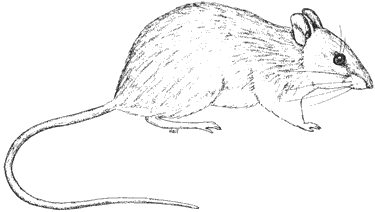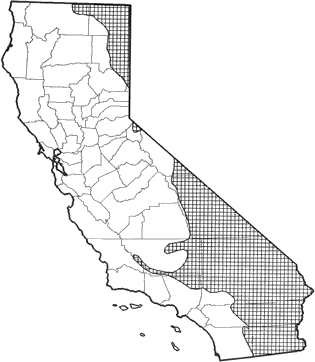
Canyon Mouse
Distribution, Abundance, and Seasonality
In California, occurs in 3 areas: the southeastern desert areas, northern Alpine Co., and the northeastern corner of the state (Modoc, eastern Siskiyou, and eastern Lassen cos.). Confined to arid, rocky areas, but found in a variety of habitats. Found in all desert and chaparral habitats, with the possible exception of chamise-redshank chaparral. Also common in subalpine conifer, eastside pine, pinyon-juniper, juniper, and Joshua tree habitats. Elevational range 0-3050 m (10,000 ft).

Range Map
Specific Habitat Requirements
Feeding: Green vegetation and seeds are consumed throughout the year. Insects are eaten when available, especially in spring and summer (Bradley and Deacon 1971, Bradley and Mauer 1973, Johnson and Armstrong 1987).
Cover: Restricted to rocky areas. Egoscue (1964) reported that plants had little influence on the distribution and abundance of this species in Utah. Coat color usually varies with color of substrate, except in Pisgah Lava Bed, San Bernardino Co. (Lawlor 1976).
Reproduction: Simple nests are built in burrows beneath rocks and in rock crevices.
Water: Free water not required. Physiological adaptations to xeric environments include ability to concentrate urine (Abbott 1971, MacMillen 1972, Blackwell and Pivorun 1979). MacMillen and Christopher (1975) demonstrated annual cycling in urine concentration; lowest concentrations occurred in winter. Respiratory water-loss reduced through circadian torpor.
Pattern: Rocky areas with virtually any plant cover.
Species Life History
Activity Patterns: Nocturnally active year-round though capable of entering daily torpor (for up to 10 hr) when stressed for food (Morhardt and Hudson 1966).
Seasonal Movements / Migration: None.
Home Range: No data found. Reported to be a quarrelsome and nervous mouse in captivity (Egoscue 1964).
Territory: No data found.
Reproduction: Seasonally polyestrous (Egoscue 1964). May reproduce year-round in California, with marked reduction of activity fall and winter (Bradley and Deacon 1971). Gestation is 24-25 days. Litter size averages 3 young (range 1-6) (Egoscue 1964). Maximum number of litters 10-13 per yr (Rood 1966). Young are weaned at 4 wk. Some breed as early as 70 days after birth.
Niche: The canyon mouse is a small granivore/omnivore of rocky, arid lands. It is closely associated with the long-tailed pocket mouse and the desert wood rat. Predators include raptors, snakes, and predatory mammals. The canyon mouse is host to 22 fleas, 4 ticks, 8 mites,1 louse, and 1 nematode (Beck and Allred 1966, Egoscue 1964).
Sources & References
California Department of Fish and Game, 1999.
California's Wildlife, Sacramento, CA.
Written by: P. Brylski, reviewed by: H. Shellhammer, edited by: R. Duke
Abbott, K. D. 1971. Water economy in the canyon mouse, Peromyscus crinitus stephensi. Comp. Biochem. Physiol. 38A:37-52. Beck, D. E., and D. M. Allred. 1966. Siphonaptera (fleas) of the Nevada test site. Brigham Young Univ. Sci. Bull. Biol. Ser. No. 7. 27pp. Blackwell, T. L., and E. B. Pivorun. 1979. Influence of temperature on the water balance of three parapatric species of Peromyscus. J. Mammal. 60:70-75. Bradley, W. G., and J. E. Deacon. 1971. The ecology of small mammals at Saratoga Springs, Death Valley National Monument, California. J. Ariz. Acad. Sci. 6:206-215. Bradley, W. G., and R. A. Mauer. 1973. Rodents of a creosote-bush community in southern Nevada. Southwest. Nat. 17:333-344. Egoscue, H. J. 1964. Ecological notes and laboratory life history of the canyon mouse. J. Mammal. 45:387-396. Johnson, D. W., and D. M. Armstrong. 1987. Peromyscus crinitus. Mammal. Species No. 287. 8pp. Lawlor, T. E. 1976. Coat color adaptations of rodents occurring on lava beds-reanalysis of an exceptional case. J. Mammal. 57:391-397. MacMillen, R. E. 1972. Water economy of nocturnal desert rodents. Sump. Zool. Soc. London 31:147-174. MacMillen, R. E., and E. A. Christopher. 1975. The water relations of two populations of non- captive desert rodents. Pages 117-137 in N. F. Hadley, ed. Environmental physiology of desert organisms. Dowden, Hutchison, and Ross, New York. 283pp. Mohardt, J. E., and J. W. Hudson. 1966. Daily torpor induced in white-footed mice (peromyscus spp.) by starvation. Nature 212:1046-1047 Rood, J. P. 1966. Observations on the reproduction of Peromyscus in captivity. Am. Midl. Nat. 76:496-503.
California Animal Facts | California's Wildlife